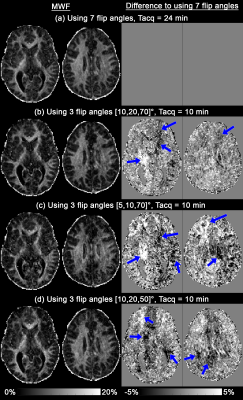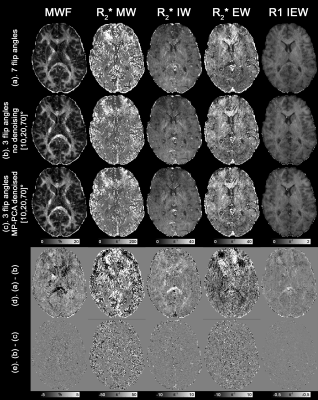Kwok-Shing Chan1 and José P. Marques1
1Donders Institute for Brain, Cognition and Behaviour, Radboud University, Nijmegen, Netherlands
1Donders Institute for Brain, Cognition and Behaviour, Radboud University, Nijmegen, Netherlands
MCR-MWI is possible with less T1w data without significantly reduce the measurement accuracy and precision. This can allow shorter scan time for high quality myelin quantification in clinical setting.

Fig. 3: Example of MWF on 2 axial slices on 1 subject using data from (a) 7 flip angles and (b-d) top 3 performed subsets of using 3 flip angles. All sets of data produced MWF maps with similar contrast globally, and noise appearance followed the pattern suggested by the simulations. (c) Substantial differences to the full dataset result can be found as patches across the brain, depending on which flip angles were used, which is likely to be caused by the artefacts in the data and potential unbalanced MT effect (blue arrows).

Fig. 5: Compare to the results of using 7 flip angles (a), high-quality MWF and other quantitative parameters can still be obtained using data from only 3 flip angles on 1.4mm isotropic data (b), though the noise in these maps is more pronounced when compared to the 1.8mm isotropic MWF in Fig.3. (c) Bias caused by artefacts is also more noticeable in the high resolution maps because of the longer scan time. (d) Results with MP-PCA denoising only show negligible differences compared to those without denoising.
